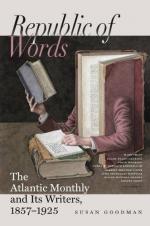And now three months have passed, for two of which I have been teaching. There are difficulties, yes, and there is hard work; but I can manage the children. I have the tact, the character, the gift, that nameless something which gives one person control over others; and for the studies, they are as yet a pleasure to me. I see how they will lead me on to other knowledge, how I may bring into form and make available my desultory reading, and there is a great pleasure in the very study itself. And for the rest, if my great grief is never out of my mind, if it is always present to me, at least I can put it back, behind my daily occupations and interests. I begin, too, to see dimly that there are other things in life for a woman to whom the light of life is denied. My heart will always be lonely; but how much there is to live for in my mind, my tastes, my love for the beautiful! My little room has taken another aspect. I have so few wants that I can readily devote part of my earnings to gratifying myself with books, pictures. Such lovely prints as I find in the print-shops! and the flowers—Tom Salyers, who is as kind as a brother, brings me them from the market. And then everything is so new to me; there is so much in life to see, to know. No, I will not be unhappy; happy I suppose I can never be, but I have strength and courage, and a will to rise above this sorrow which once crushed me to the ground. When I wrote the bitter words with which this record begins, I wronged the kind hearts that are around me, I lacked faith in that world wherein I have found help and comfort.
* * * * *
On the relation of art to nature.
In two parts.
PART I.
The notion that Painting and Sculpture are concerned only with the “imitation of Nature,”—that is, with copying the forms and colors of existing things,—though so often expelled, as it were, with a pitchfork, persistently recurs, not only in popular talk, but in deliberate criticism, and in the practice of artists. There are periods when this notion gets the upperhand, as at the end of the fifteenth century, and again at the end of the eighteenth, when Rousseau prescribed a return to Nature as the panacea for all defect, in Art as elsewhere. Then Winckelmann and his successors triumphed over it for a while,—showed at least the crudity of that statement. This is the purpose of much of Sir Joshua Reynolds’s lectures. Now it seems to be coming up again,—thanks partly to Mr. Ruskin, though he might be quoted on both sides,—and this time with some prospect of demonstrating, by the aid of photography, what it does in fact amount to.




